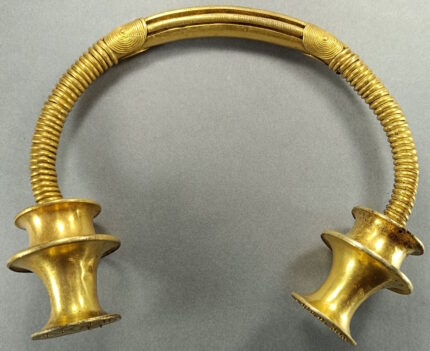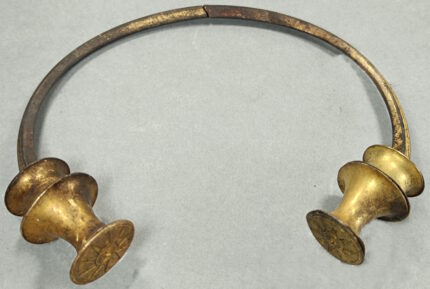A worker at a water company in Cavandi, Asturias, northwest Spain, uncovered two 2,500-year-old gold torcs while working on the municipal water pipes two weeks ago. They are of extraordinarily high quality and feature a striking diversity of goldsmithing techniques and decorative motifs, including casting, filigree, granulation, welding, and a variety of geometric designs. It is the most important torc find in Asturias, the only one made in situ and to be studied by archaeologists at the time of discovery.
While other gold necklaces from the Iron Age have been found, most were discovered in the 18th and 19th centuries, when limited archaeological techniques meant much of the information about their provenance was lost, [Pablo] Arias [,professor of prehistoric archeology at the University of Cantabria,] explained.
In this case, the site is intact, giving archaeologists a much better idea of their context, he added.
“We have very precise information about where they were found,” said Arias. “It’s quite exceptional.”
Sergio Narciandi was tracing the route of an outage when he saw a shiny object on a slope next to the road. At first he assumed it was a random piece of metal from a goat farm or agricultural equipment in the area, but the brightness of the metal gave him pause. When he took a closer look, he realized it looked a lot like a torc, and a gold one at that.
He knew it needed to be reported to authorities, but he had to hunt around for a while to identify the appropriate authority, so he dialed the mayor, whom he knows personally, and the mayor told him he could deposit at city hall until the cultural patrimony officials took over. Finally Narciandi called his uncle, an archaeologist, and the uncle connected him to the director of the Archaeological Museum of Asturias.
After this round-robin of calls, archaeologists made it to the find site that very afternoon. The confirmed the object was a gold torc, then found six fragments of a second torc on the same hillside. The fragments formed a complete second gold torc. Both torcs were then swiftly transported to the museum’s laboratory for conservation.
The torc discovered by Sergio Narciandi is a rigid, c-shaped necklace in the Astur-Norgalaico style of the Celtic tribes in what is now Asturias and Galicia. It is formed of a central rod with spirals of gold wound around it and has large double vasiform terminals. Because of its size, quality, finished and technical difficulty, the first torc is considered an exceptional example of goldsmithing from the northwest of the Iberian peninsula during the Iron Age. The second piece has a rectangular section with double vasiform terminals engraved with sunburst designs on the flat ends. Both of them have wear on areas that would have been in contact with the neck, so we know that they were actively used for some time.
The torcs are now undergoing non-invasive metallurgic analysis and surface examination. This will shed new light on the manufacturing technology of Iron Age Spain, the mining of metal, the use of silver, gilding techniques and more.
* This article was originally published here










No comments:
Post a Comment